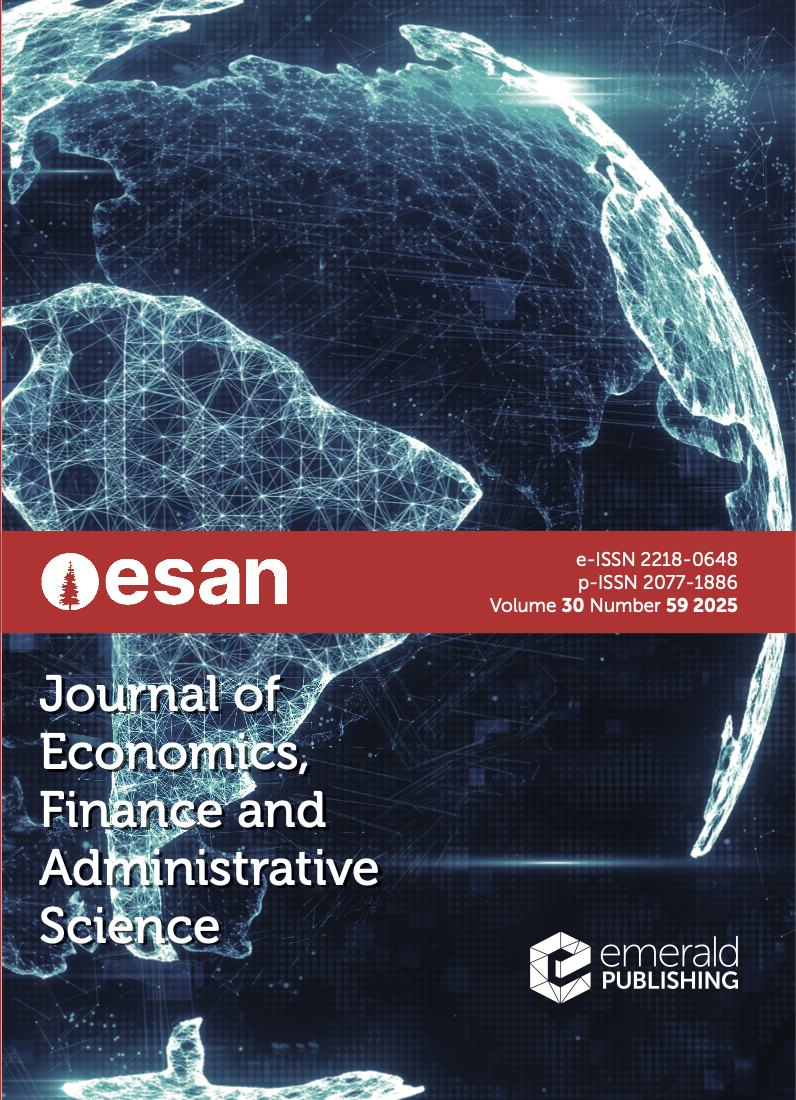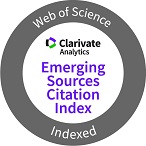Investor sentiment and equity mutual fund performance in Brazil
Keywords:
Sentiment index, Asset pricing models, Equity funds, Fund performance, BrazilAbstract
PurposeFocusing on the Brazilian equity mutual fund industry, this study analyzes whether including the investor sentiment index in asset pricing models is important for explaining fund alpha.
Design/methodology/approachThe investor sentiment index and risk factors in the Fama and French (1993) and Carhart (1997) models were estimated, the risk-adjusted performance of a sample of equity mutual funds in Brazil was evaluated, and a United States (US) sample was included for a complementary perspective. The sample period spans 2010–2019 for Brazil and 2010–2018 for the US.
FindingsThe results contrasted with those evidenced in the US, where the sentiment index was an important factor in explaining the probability of alpha occurrence, especially in the case of winner funds, defined as those exhibiting a positive and statistically significant alpha at the 5% level. Overall, the findings suggest that, in the Brazilian market, pricing models incorporating investor sentiment as an additional factor fail to adequately capture the outperformance probability of equity mutual funds. These results suggest that the factors influencing fund performance may differ between the two countries and highlight the relevance of developing more suitable investor sentiment indicators for emerging markets.
Originality/valueThis study examines the impact of the sentiment index on the performance of equity mutual funds in Brazil, specifically its influence on alpha generation.
Downloads
References
Anand, A., Basu, S., Pathak, J. and Thampy, A. (2021), “The impact of sentiment on emerging stock markets”, International Review of Economics and Finance, Vol. 75, pp. 161-177, doi: 10.1016/j.iref.2021.04.005.
Anbima (2020), “Consolidado histórico de fundos de investimentos - Fevereiro/2021”, available at: https://www.anbima.com.br/pt_br/informar/estatisticas/fundos-de-investimento/fi-consolidado-historico.htm
Baker, M. and Wurgler, J. (2006), “Investor sentiment and the cross‐section of stock returns”, The Journal of Finance, Vol. 61 No. 4, pp. 1645-1680, doi: 10.1111/j.1540-6261.2006.00885.x.
Baker, M. and Wurgler, J. (2007), “Investor sentiment in the stock market”, The Journal of Economic Perspectives, Vol. 21 No. 2, pp. 129-152, doi: 10.1257/jep.21.2.129, available at: https://www.nber.org/system/files/working_papers/w13189/w13189.pdf
Bandopadhyaya, A. and Jones, A.L. (2006), “Measuring investor sentiment in equity markets”, Journal of Asset Management, Vol. 7 No. 3, pp. 208-215, doi: 10.1057/palgrave.jam.2240214.
Bitencourt, W.A. and Iquiapaza, R.A. (2024), “Economic policy uncertainty, sentiment and Brazilian stock market performance”, Revista Contabilidade and Finanças, Vol. 35 No. 94, e1877, doi: 10.1590/1808-057x20231877.en.
Borges, E.C. and Martelanc, R. (2015), “Sorte ou habilidade: uma avaliação dos fundos de investimento no Brasil”, Revista de Administracao, Vol. 50 No. 2, pp. 196-207, doi: 10.5700/rausp1194.
Brown, G.W. and Cliff, M.T. (2004), “Investor sentiment and the near-term stock market”, Journal of Empirical Finance, Vol. 11 No. 1, pp. 1-27, doi: 10.1016/j.jempfin.2002.12.001.
Bu, Q. (2020a), “Investor sentiment and mutual fund alpha”, The Journal of Behavioral Finance, Vol. 21 No. 1, pp. 57-65, doi: 10.1080/15427560.2019.1594814.
Bu, Q. (2020b), “Mutual fund alpha: is it managerial or emotional?”, The Journal of Behavioral Finance, Vol. 22 No. 1, pp. 46-55, doi: 10.1080/15427560.2020.1716361.
Carhart, M.M. (1997), “On persistence in mutual fund performance”, The Journal of Finance, Vol. 52 No. 1, pp. 57-82, doi: 10.1111/j.1540-6261.1997.tb03808.x.
Cavalcante-Filho, E., De-Losso, R. and Santos, J.C.S. (2021), “Which factors matter to investors? Evidence from Brazilian mutual funds”, Revista Brasileira de Gestão de Negócios, Vol. 23 No. 01, pp. 63-80, doi: 10.7819/rbgn.v23i1.4088.
Cheong, C.W., Sinnakkannu, J. and Ramasamy, S. (2017), “Reactive or proactive? Investor sentiment as a driver of corporate social responsibility”, Research in International Business and Finance, Vol. 42, pp. 572-582, doi: 10.1016/j.ribaf.2017.07.002.
Corredor, P., Ferrer, E. and Santamaria, R. (2013), “Investor sentiment effect in stock markets: stock characteristics or country-specific factors?”, International Review of Economics and Finance, Vol. 27, pp. 572-591, doi: 10.1016/j.iref.2013.02.001.
Elton, E.J., Gruber, M.J. and Blake, C.R. (1996), “Survivor bias and mutual fund performance”, Review of Financial Studies, Vol. 9 No. 4, pp. 1097-1120, doi: 10.1093/rfs/9.4.1097.
Fama, E.F. (1970), “Efficient capital markets: a review of theory and empirical work”, The Journal of Finance, Vol. 25 No. 2, pp. 383-417, doi: 10.1111/j.1540-6261.1970.tb00518.x.
Fama, E.F. and French, K.R. (1993), “Common risk factors in the returns on stocks and bonds”, Journal of Financial Economics, Vol. 33 No. 1, pp. 3-56, doi: 10.1016/0304-405X(93)90023-5.
Fama, E. and French, K. (2010), “Luck versus skill in the cross section of mutual funds returns”, The Journal of Finance, Vol. 65 No. 5, pp. 1915-1947, doi: 10.1111/j.1540-6261.2010.01598.x.
Fama, E.F. and French, K.R. (2015), “A five-factor asset pricing model”, Journal of Financial Economics, Vol. 116 No. 1, pp. 1-22, doi: 10.1016/j.jfineco.2014.10.010.
Fama, E.F. and French, K.R. (2016), “Dissecting anomalies with a five-factor model”, The Review of Financial Studies, Vol. 29 No. 1, pp. 69-103, doi: 10.1093/rfs/hhv043.
Fernandes, A.R.D.J., Fonseca, S.E. and Iquiapaza, R.A. (2018), “Modelos de mensuração de desempenho e sua influência na captação líquida de fundos de investimento”, Revista Contabilidade and Finanças, Vol. 29 No. 78, pp. 435-451, doi: 10.1590/1808-057x201805330.
Firth, M., Wang, K. and Wong, S.M. (2015), “Corporate transparency and the impact of investor sentiment on stock prices”, Management Science, Vol. 61 No. 7, pp. 1630-1647, doi: 10.1287/mnsc.2014.1911.
Fonseca, S.E. (2022), “Fundos de investimento: market timing, sentimento do investidor e incerteza da política econômica”, Tese de doutorado, Universidade Federal de Minas Gerais, available at: http://hdl.handle.net/1843/50770
Grinblatt, M. and Titman, S. (1993), “Performance measurement without benchmarks: an examination of mutual fund returns”, Journal of Business, Vol. 66 No. 1, pp. 47-68, doi: 10.1086/296593, available at: http://www.jstor.org/stable/2353341
Hillier, D. and Loncan, T. (2019), “Political uncertainty and stock returns: evidence from the Brazilian political crisis”, Pacific-Basin Finance Journal, Vol. 54, pp. 1-12, ISSN 0927-538X, doi: 10.1016/j.pacfin.2019.01.004.
Jensen, M.C. (1968), “The performance of mutual funds in the period 1945-1964”, The Journal of Finance, Vol. 23 No. 2, pp. 389-416, doi: 10.2307/2325404.
Jiang, G.J. and Yüksel, H.Z. (2019), “Sentimental mutual fund flows”, Financial Review, Vol. 54 No. 4, pp. 709-738, doi: 10.1111/fire.12201.
Johnson, R.A. and Wichern, D.W. (2007), Applied Multivariate Statistical Analysis, Pearson Prentice Hall, Upper Saddle River, NJ.
Lee, C.M., Shleifer, A. and Thaler, R.H. (1991), “Investor sentiment and the closed‐end fund puzzle”, The Journal of Finance, Vol. 46 No. 1, pp. 75-109, doi: 10.1111/j.1540-6261.1991.tb03746.x.
Lintner, J. (1965), “Security prices, risk, and maximal gains from diversification”, The Journal of Finance, Vol. 20 No. 4, pp. 587-615, doi: 10.2307/2977249.
MacKinnon, J.G. and White, H. (1985), “Some heteroskedasticity-consistent covariance matrix estimators with improved finite sample properties”, Journal of Econometrics, Vol. 29 No. 3, pp. 305-325, doi: 10.1016/0304-4076(85)90158-7.
Maestri, C.O.N.M. and Malaquias, R.F. (2018), “Aspects of manager, portfolio allocation, and fund performance in Brazil”, Revista Contabilidade and Finanças, Vol. 29 No. 76, pp. 82-96, doi: 10.1590/1808-057x201804590.
Massa, M. and Yadav, V. (2015), “Investor sentiment and mutual fund strategies”, Journal of Financial and Quantitative Analysis, Vol. 50 No. 4, pp. 699-727, doi: 10.1017/s0022109015000253, available at: https://www.jstor.org/stable/43862270
Miranda, K.F., Machado, M.A. and Macedo, L.A. (2018), “Investor sentiment and earnings management: does analysts' monitoring matter?”, RAM. Revista de Administração Mackenzie, Vol. 19 No. 4, doi: 10.1590/1678-6971/eramf180104.
Mossin, J. (1966), “Equilibrium in a capital asset market”, Econometrica: Journal of the Econometric Society, Vol. 34 No. 4, pp. 768-783, doi: 10.2307/1910098.
Nerasti, J.N. and Lucinda, C.R. (2016), “Persistência de desempenho em fundos de ações no Brasil”, Brazilian Review of Finance, Vol. 14 No. 2, pp. 269-297, doi: 10.12660/rbfin.v14n2.2016.57958.
Paraboni, A.L., Righi, M.B., Vieira, K.M. and Silveira, V.G. (2018), “The relationship between sentiment and risk in financial markets”, BAR - Brazilian Administration Review, Vol. 15 No. 1, e170055, doi: 10.1590/1807-7692bar2018170055.
Santana, C.V.S., Santos, L.P.G.D., Carvalho Júnior, C.V.D.O. and Martinez, A.L. (2020), “Investor sentiment and earnings management in Brazil”, Revista Contabilidade and Finanças, Vol. 31 No. 83, pp. 283-301, doi: 10.1590/1808-057x201909130.
Sharpe, W.F. (1964), “Capital asset prices: a theory of market equilibrium under conditions of risk”, The Journal of Finance, Vol. 19 No. 3, pp. 425-442, doi: 10.1111/j.1540-6261.1964.tb02865.x.
Shrestha, N. (2021), “Factor analysis as a tool for survey analysis”, American Journal of Applied Mathematics and Statistics, Vol. 9 No. 1, pp. 4-11, doi: 10.12691/ajams-9-1-2, available at: https://pubs.sciepub.com/ajams/9/1/2/index.html
Silva, S.E., Roma, C.M.D.S. and Iquiapaza, R.A. (2018), “Does the management fee signal the performance of equity investment funds in Brazil?”, Revista de Educação e Pesquisa em Contabilidade, Vol. 12 No. 3, pp. 275-290, doi: 10.17524/repec.v12i3.1717.
Silva, S.E.D., Roma, C.M.D.S. and Iquiapaza, R.A. (2020), “Portfolio turnover and performance of equity investment funds in Brazil”, Revista Contabilidade e Finanças, Vol. 31 No. 83, pp. 332-347, doi: 10.1590/1808-057x201909420.
Torre-Torres, O.V.D.L., Figeroa, E.G. and Río-Rama, M.D.L.C.D. (2021), “The Fama-French multifactor model with market and Pandemic news fear sentiments: a test in the Mexican stock markets”, Contaduría y Administración, Vol. 66 No. 5, p. 303.
Wang, J., Wang, X., Yang, J. and Zhuang, X. (2020), “Impact of investor sentiment on mutual fund risk taking and performance: evidence from China”, Enterprise Information Systems, Vol. 14 No. 6, pp. 833-857, doi: 10.1080/17517575.2020.1758795.
Wang, J., Yi, S., Wang, X., Yang, J. and Jiang, Z. (2021), “How do mutual funds in China exploit investor sentiment?”, Emerging Markets Finance and Trade, Vol. 57 No. 14, pp. 1-16, doi: 10.1080/1540496X.2020.1784715.
Xavier, G.C. and Machado, M.A.V. (2017), “Anomalies and investor sentiment: empirical evidences in the Brazilian market”, BAR - Brazilian Administration Review, Vol. 14No No. 3, e170028, doi: 10.1590/1807-7692bar2017170028.
Yoshinaga, C.E. and Castro Junior, F.H.F.D. (2012), “The relationship between market sentiment index and stock rates of return: a panel data analysis”, BAR - Brazilian Administration Review, Vol. 9 No. 2, pp. 189-210, doi: 10.1590/S1807-76922012000200005











